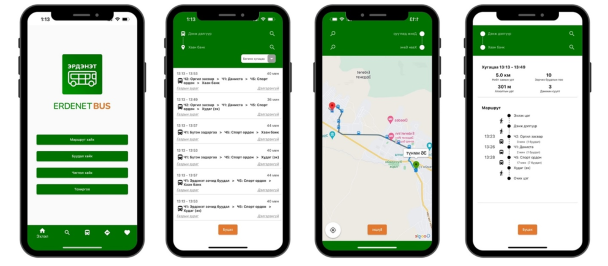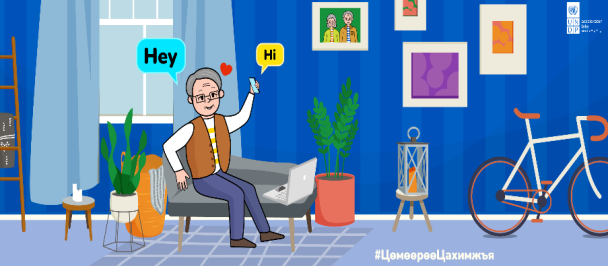Even though his motor neuron disease had left him all, but completely immobile, world-famous scientist Stephen Hawking made a sensational TED talk in 2008: the voice emulator that Professor Hawking used is now well-recognized for it made the impossible possible by transferring muscle signals into words. This example shows how technology and other developments in IT can help people with disabilities to gain independence, open new opportunities, and transform their lives.
Accessibility
With the most essential services now existing online, making web content accessible to people with disabilities (a notion commonly referred to as ‘Accessibility’) also gains attention. Web developers around the world created and approved accessibility principles, methodologies, and standards in the Web Content Accessibility Guidelines (WCAG).
At UNDP Mongolia Accelerator Lab, we believe that accessibility is a gateway for people with disabilities to develop their digital skills and to be able to participate actively in all aspects of life which are becoming increasingly digitalized. Leading with the purpose to learn about the accessibility situation in Mongolia, as well as for testing out ways of introducing these concepts, we conducted two experiments.
The First Experiment
Our first experiment looked at the accessibility of existing websites and applications. In association with the Mongolian National Federation of the Blind, we first chose a sample of seven widely used websites and applications, such as government services, shopping, banking, news, and entertainment.
Then, we developed an accessibility testing methodology that involved people testing each website for common accessibility related issues. To ensure the consistency of the findings, each site was checked by three different individuals, and then finally were run with special accessibility software.
The testing revealed that the selected websites attempted to make their interface more user friendly, but nevertheless, when it came to individuals with special needs, there were still certain issues that needed to be resolved. For instance, the color scheme on some of the websites may not have presented an issue for a visually abled person, but for someone with some level of visual impairment it had the potential to create difficulty to differentiate between the background and the actual text. This kind of issue could have been a simple oversight in the design, but nonetheless it is a problem that presents a barrier for anyone with a visual impairment in accessing the website.
In other instances, some websites contained a lot of images and diagrams as the main form of information. However, the problem is that without proper text labels, assistive technologies such as screen readers are not able to read these images, and therefore, visually impaired people were likely to miss out on crucial parts of information. In other words, the website is not as effective for delivering the information in creative and effective way to people with a visual disability.
A similar issue to the above is when a website contains a lot of video and audio content with no supplementary texts, subtitles, or sign language, meaning that those with hearing issues cannot decipher what is being conveyed. Thus, the website is not as effective for people with a hearing disability as it could be.
The Second Experiment
Given the breadth of accessibility issues, our second experiment was aimed at coming up with solutions. We focused on front-end developers and providing them with the skills and know-how to be able solve accessibility issues, such as in the examples provided above.
We sourced Deque Software, an Indian company that focuses on accessibility testing and skills building, and we organized a 3-day training event on the latest web and native accessibility features. We invited the developers of the tested websites and applications to attend the training. During the training sessions, the participants shared that they had never understood why complaints were being manifested from users, as they felt the website they had designed was running perfectly, in a technical sense.
However, through the training event they began to understand where these dissatisfactions were emanating from. Through physical testing of the accessibility features of their websites and applications, they discovered that a step that would take a normally an abled person 10 minutes to achieve would require almost an hour for a person with limited abilities.
As a result of this realization, they were thankful to us for guiding them, and giving them the tools to recognize techniques and step-by-step solutions to be able to improve accessibility of the websites and applications they had designed for people with disabilities. Furthermore, they requested to have such training on a continual basis, so that more developers could learn and apply accessibility in their work and develop websites and applications truly for all users.
Summary of Our Learnings
From our two experiments, our key learnings are as follows:
· Accessibility is everyone: When we started our experiments, we focused on people with sight or hearing loss as they are often the target group who primarily come to mind for the web accessibility. However, this leads to the misconception that accessibility caters to only a small fraction of the population and, therefore, is not very important. Even though there may be not many people with permanent loss of abilities, there are many more instances of people having temporary loss of abilities due to illness or accidents, as well as some abilities declining with age. With accessibility features, people can overcome these inconveniences without much reliance on others and without compromising on the quality of life. Therefore, the importance of accessibility is not something that should be overlooked by physically able people, as it is something that benefits everyone in the long run.
· Address the misconceptions: We also learned that accessibility is still quite a new notion in Mongolia and many people understand it as a complicated, technical, and code heavy process. As such, many people believe that accessibility is expensive, or any attempts to incorporate accessibility would compromise the design and attractiveness of websites and applications. This have led to the will and inclination to adopt accessibility practices to be less than it should or could be. Notwithstanding, our training session with website developers was a fresh outlook that to ensure accessibility, one does not need to develop a new set of codes and the design and visual aesthetic of web pages does not have to be jeopardized. It is important to raise awareness and understanding about accessibility concepts, as well as cultivate compassion to users through addressing misunderstandings and preconceived assumptions.
· Accessibility integrated design: In order to truly save on costs, it is essential to think about accessibility early on, and embed it as soon as possible during the initial design and development of new websites or applications. Although it is still possible to include accessibility features at the later stage, this would require more time and resources to ‘retrofit’ an element that would be more perceived as an afterthought, rather than something that is truly embedded in the structure of the website from the beginning.
· Involve the users: Lastly, in any design process it is important to involve people with disabilities as well as other high-need groups. In this way, it becomes possible to integrate their actual needs, respond to their desires, and bring the comfort and familiarity to the next level. This level of integration not only catches a wider audience, thus proving the raison d’étre of the internet in the information age, but from a commercial perspective is advantageous for a company/organization as it vastly improves their reputation.
Going Forward
With the government now in the process of approving the national accessibility standards, there is a need to provide accessibility training to the professionals (and to ensure that specialist accessibility trainers are made available for the process); and to establish compliance and quality assurance systems alongside the participation of the target groups.
Overall, our research and engagement have produced valuable and positive results. We hope that our experiments demonstrated some ways of setting the system up, and also that there is a significant interest from both private and public organizations to ensure accessibility for web and applications are met for everyone.

 Locations
Locations

